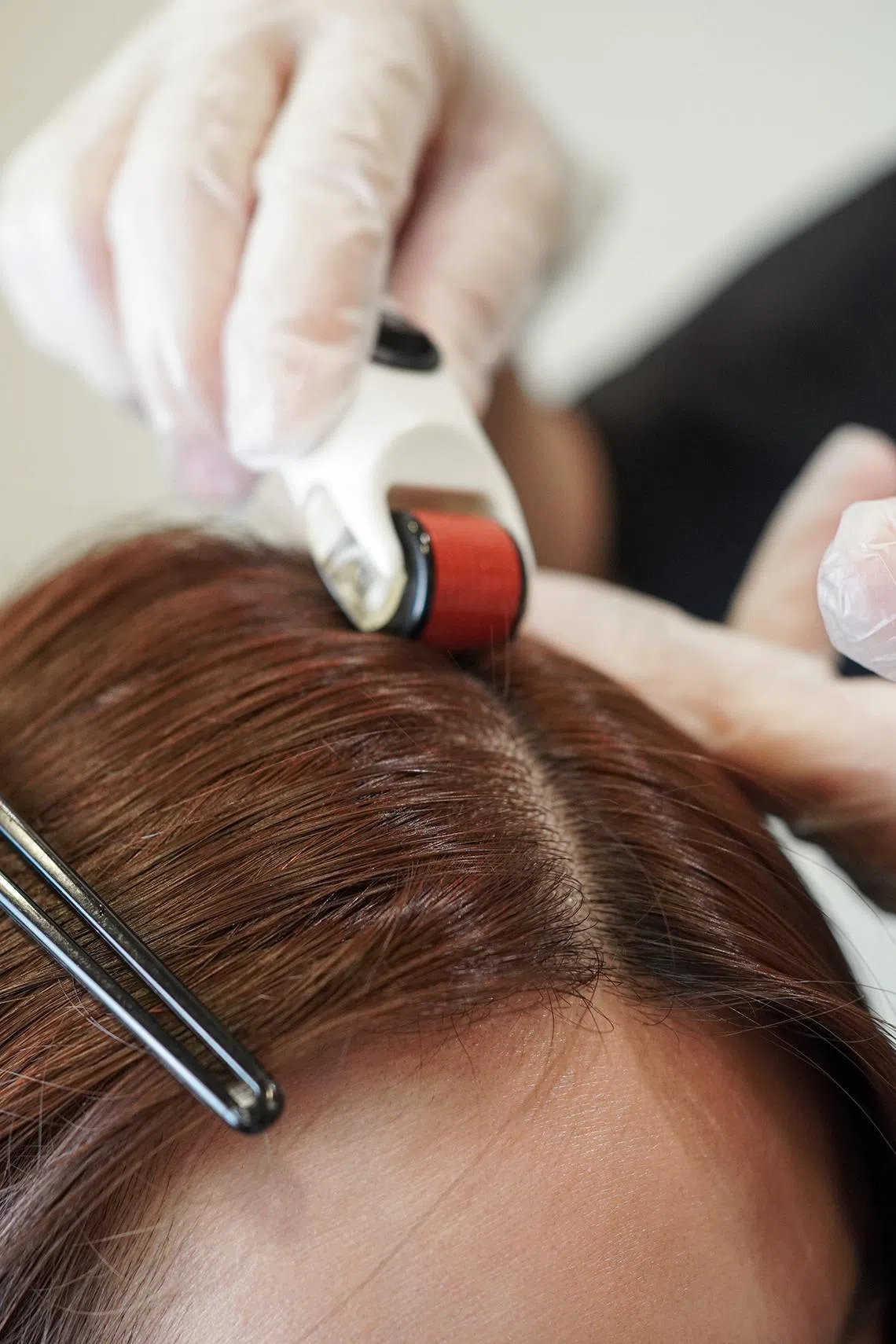BRANDED CONTENT
Microneedling, energy pulses: How exosome treatments support scalp care
At Svenson, the innovative cellular technology targets the foundation of hair appearance by addressing underlying scalp conditions

Factors like genetics, lifestyle and scalp health can contribute to hair loss, says Svenson’s group chief trichologist Kim Fong.
PHOTO: GETTY IMAGES
Follow topic:
Poor sleep, unmanaged stress, smoking, frequent chemical treatments and inadequate scalp care are all lifestyle factors that can contribute to hair thinning.
“Many young adults today are experiencing hair loss earlier, and much of it can be traced back to poor lifestyle choices,” says Ms Kim Fong, group chief trichologist at Svenson
While hair loss is often seen as cosmetic or a part of ageing, it can signal deeper health concerns. Ms Fong advises seeking professional help if you notice more hair than usual in your brush or clogging the drain.
Hair loss can take many forms – from mild thinning and patchy bald spots to total baldness. Its causes are just as varied, ranging from lifestyle and hormonal shifts to genetics and underlying medical conditions.
Telogen effluvium, a temporary shedding triggered by stress, poor nutrition, illness, or hormonal changes, is one example. Nutrient deficiencies – especially in protein, iron and vitamin A – can affect hair appearance and scalp health.
Androgenetic alopecia, or male-pattern baldness, is another common condition linked to genetics, affecting both men and women, though more prominently in men.

Ms Kim Fong, chief trichologist at Svenson, advises seeking professional help if you notice unusual or excessive hair shedding.
PHOTO: SVENSON
Alopecia areata, an autoimmune condition where white blood cells attack hair follicles, can lead to sudden bald patches. “While no specific trigger has been confirmed, we often see links to emotional stress or physical trauma,” says Ms Fong. Untreated, it can progress to alopecia totalis, or complete hair loss.
Underlying all of this is one key message: your scalp health matters. “Just as plants need healthy soil to grow, your scalp acts as the foundation for strong, healthy hair,” explains Ms Fong. Even something as seemingly minor as dandruff can become problematic if scratching leads to follicle damage.
“The scalp and hair are closely connected – we need to care for both, not just one,” she adds.
Boosting scalp health with exosome treatments
As scalp care becomes more advanced, scientists are looking closely at cellular interactions. This has sparked interest in exosomes – tiny particles released by cells that help them communicate, says Ms Fong.
“Exosomes can interact with cells in the scalp,” explains Ms Fong. “ Research suggests
Launched in September 2024, Svenson’s Micro-Exo treatment uses exosomes to address scalp concerns, including scalp ageing and stress-related issues. Approved by the Health Sciences Authority, it is suitable for anyone aged 21 and above dealing with hair concerns.

The microneedling technique is one of two methods Svenson uses to deliver exosomes for addressing scalp concerns.
PHOTO: SVENSON
For ageing scalp, the treatment aims to support blood flow and improve the scalp environment. For those concerned about fine or weak-looking hair, the treatment focuses on delivering proteins that may contribute to scalp health.
The treatment also addresses scalp conditions related to stress-related concerns by focusing on supporting the scalp environment.
At Svenson, exosomes are delivered through two methods:
Microneedling: Creates tiny channels in the skin for deeper absorption. It also aims to improve blood flow by triggering the skin’s natural healing response. Ms Fong says the treatment is generally comfortable on thicker skin, though individuals with sensitive scalps may experience mild discomfort.
Needleless technique: Uses electrical pulses to open microscopic channels. This FDA-approved, gentler option focuses on absorption and circulation, ideal for those preferring a less invasive approach.
Ms Fong typically recommends a series of six to eight sessions, spaced one to two weeks apart.
With microneedling, customers may experience temporary redness or tenderness after treatment. While they can wash their hair after four hours, Ms Fong generally advises waiting 24 hours. She also recommends avoiding intensive or outdoor activities – such as swimming, gym workouts, saunas, or prolonged sun exposure – for at least three days.
The needleless approach involves fewer restrictions. Most individuals can resume their usual activities, including hair washing, after about four hours.
For more information, visit Svenson
Disclaimer: There is no conclusive scientific proof that any product (except certain registered medicinal products) or service can retard hair loss or promote hair growth.


